Related Research Articles

Stainless steel, also known as inox, corrosion-resistant steel (CRES), and rustless steel, is an iron-based alloy containing a minimum level of chromium that is resistant to rusting and corrosion. Stainless steel's resistance to corrosion results from the 10.5%, or more, chromium content which forms a passive film that can protect the material and self-heal in the presence of oxygen. It can also be alloyed with other elements such as molybdenum, carbon, nickel and nitrogen to develop a range of different properties depending on its specific use.
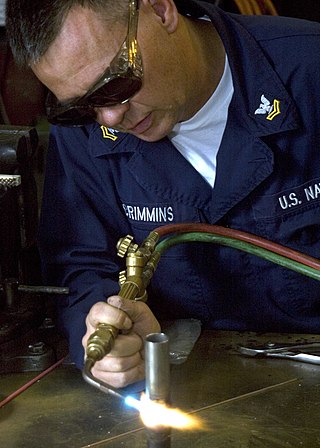
Brazing is a metal-joining process in which two or more metal items are joined by melting and flowing a filler metal into the joint, with the filler metal having a lower melting point than the adjoining metal.

A rivet is a permanent mechanical fastener. Before being installed, a rivet consists of a smooth cylindrical shaft with a head on one end. The end opposite the head is called the tail. On installation, the deformed end is called the shop head or buck-tail.

A fastener or fastening is a hardware device that mechanically joins or affixes two or more objects together. In general, fasteners are used to create non-permanent joints; that is, joints that can be removed or dismantled without damaging the joining components. Steel fasteners are usually made of stainless steel, carbon steel, or alloy steel.

Monel is a group of alloys of nickel and copper, with small amounts of iron, manganese, carbon, and silicon. Monel is not a cupronickel alloy because it has less than 60% copper.
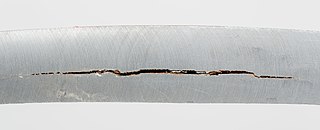
Hydrogen embrittlement (HE), also known as hydrogen-assisted cracking or hydrogen-induced cracking (HIC), is a reduction in the ductility of a metal due to absorbed hydrogen. Hydrogen atoms are small and can permeate solid metals. Once absorbed, hydrogen lowers the stress required for cracks in the metal to initiate and propagate, resulting in embrittlement. Hydrogen embrittlement occurs in steels, as well as in iron, nickel, titanium, cobalt, and their alloys. Copper, aluminium, and stainless steels are less susceptible to hydrogen embrittlement.
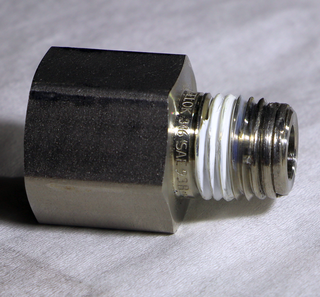
Galling is a form of wear caused by adhesion between sliding surfaces. When a material galls, some of it is pulled with the contacting surface, especially if there is a large amount of force compressing the surfaces together. Galling is caused by a combination of friction and adhesion between the surfaces, followed by slipping and tearing of crystal structure beneath the surface. This will generally leave some material stuck or even friction welded to the adjacent surface, whereas the galled material may appear gouged with balled-up or torn lumps of material stuck to its surface.

Gas tungsten arc welding is an arc welding process that uses a non-consumable tungsten electrode to produce the weld. The weld area and electrode are protected from oxidation or other atmospheric contamination by an inert shielding gas. A filler metal is normally used, though some welds, known as 'autogenous welds', or 'fusion welds' do not require it. A constant-current welding power supply produces electrical energy, which is conducted across the arc through a column of highly ionized gas and metal vapors known as a plasma.

Inconel is a nickel-chromium-based superalloy often utilized in extreme environments where components are subjected to high temperature, pressure or mechanical loads. Inconel alloys are oxidation- and corrosion-resistant. When heated, Inconel forms a thick, stable, passivating oxide layer protecting the surface from further attack. Inconel retains strength over a wide temperature range, attractive for high-temperature applications where aluminum and steel would succumb to creep as a result of thermally-induced crystal vacancies. Inconel's high-temperature strength is developed by solid solution strengthening or precipitation hardening, depending on the alloy.
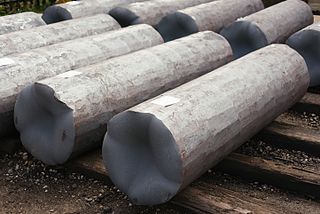
Titanium alloys are alloys that contain a mixture of titanium and other chemical elements. Such alloys have very high tensile strength and toughness. They are light in weight, have extraordinary corrosion resistance and the ability to withstand extreme temperatures. However, the high cost of processing limits their use to military applications, aircraft, spacecraft, bicycles, medical devices, jewelry, highly stressed components such as connecting rods on expensive sports cars and some premium sports equipment and consumer electronics.
Marine grade stainless alloys typically contain molybdenum to resist the corrosive effects of NaCl or salt in seawater. Concentrations of salt in seawater can vary, and splash zones can cause concentrations to increase dramatically from the spray and evaporation.
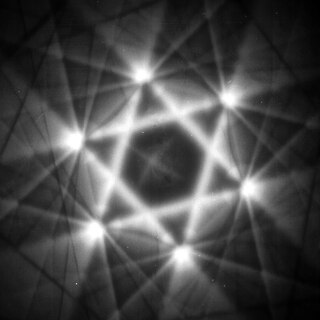
Austenitic stainless steel is one of the five classes of stainless steel as defined by crystalline structure. Its primary crystalline structure is austenite. Such steels are not hardenable by heat treatment and are essentially non-magnetic. This structure is achieved by adding enough austenite-stabilizing elements such as nickel, manganese and nitrogen. The Incoloy family of alloys belong to the category of super austenitic stainless steels.

The SAE steel grades system is a standard alloy numbering system for steel grades maintained by SAE International.
6061 aluminium alloy is a precipitation-hardened aluminium alloy, containing magnesium and silicon as its major alloying elements. Originally called "Alloy 61S", it was developed in 1935. It has good mechanical properties, exhibits good weldability, and is very commonly extruded. It is one of the most common alloys of aluminium for general-purpose use.
Ferritic nitrocarburizing or FNC, also known by the proprietary names "Tenifer", "Tufftride", Melonite, and "Arcor", is a range of proprietary case hardening processes that diffuse nitrogen and carbon into ferrous metals at sub-critical temperatures during a salt bath. Other methods of ferritic nitrocarburizing include gaseous processes such as Nitrotec and ion (plasma) ones. The processing temperature ranges from 525 °C (977 °F) to 625 °C (1,157 °F), but usually occurs at 565 °C (1,049 °F). Steel and other ferrous alloys remain in the ferritic phase region at this temperature. This allows for better control of the dimensional stability that would not be present in case hardening processes that occur when the alloy is transitioned into the austenitic phase. There are four main classes of ferritic nitrocarburizing: gaseous, salt bath, ion or plasma, and fluidized-bed.
Zeron 100 is a super duplex stainless steel developed by Rolled Alloys. The alloy has excellent corrosion resistance combined with high strength. It typically contains 25% chromium and 7% nickel and 3.6% molybdenum along with copper and tungsten additions. Zeron 100 has a 50–50 austenitic–ferritic structure. It also has greater resistance to chloride pitting, crevice corrosion and stress corrosion cracking than exhibited by the standard 300 series stainless steels.
SAF 2205, is a Alleima-owned trademark for a 22Cr duplex (ferritic-austenitic) stainless steel. SAF derives from Sandvik Austenite Ferrite. The nominal chemical composition of SAF 2205 is 22% chromium, 5% nickel, 3.2% molybdenum and other alloying elements such as nitrogen and manganese. The UNS designation for SAF 2205 is S31803/S32205 and the EN steel no. is 1.4462. SAF 2205 or Duplex 2205 is often used as an alternative to expensive 904L stainless steel owing to similar properties but cheaper ingredients. Duplex stainless steel is available in multiple forms like bars, billets, pipes, tubes, sheets, plates and even processed to fittings and flanges.
440C is a martensitic 400 series stainless steel, and has the highest carbon content of the 400 stainless steel series. It can be heat treated to reach hardness of 58 to 60 HRC. It can be used to make rolling contact stainless bearings, e.g. ball bearings and roller bearings. It is also used to make knife blades.

SAE 304 stainless steel is the most common stainless steel. It is an alloy of iron, carbon, chromium and nickel. It is an austenitic stainless steel, and is therefore not magnetic. It is less electrically and thermally conductive than carbon steel. It has a higher corrosion resistance than regular steel and is widely used because of the ease in which it is formed into various shapes.
References
- 1 2 Harold M. Cobb (2010). The History of Stainless Steel. ASM International. p. 305. ISBN 9781615030118 . Retrieved March 19, 2017.
- ↑ United States Patent and Trademark Office (March 23, 2022). "NITRONIC Serial# 73219917". p. 1. Retrieved January 13, 2023.
- ↑ "When your application is critical, when there is no room for error, your choice is Electralloy". Electralloy. 2017.
Electralloy is North America's exclusive licensed producer of all NITRONIC® bar, billet, coil rod, master alloy pigs and ingot products as well as NITRONIC® weld wire and weld consumables.
- ↑ C. G. Fountzoulas; E. M. Klier; J. E. Catalano (2016). Dan Casem; Leslie Lamberson; Jamie Kimberley (eds.). Dynamic Behavior of Materials, Volume 1: Dynamic Characterization of Nitronic 30, 40 and 50 Series Stainless Steels. Springer. p. 22. ISBN 978-3319411323 . Retrieved March 19, 2017.
- ↑ Bruce Emmons (June 27, 2016). "Ultralight Electric Bus". p. 1. Retrieved March 19, 2017.
- ↑ Di Giovanni, Mario (1982). Flat and Corrugated Diaphragm Design Handbook. CRC Press. p. 42. ISBN 9780824712815.
- ↑ Dan Spurr (January–April 1982). "Cruising World". p. 68. Retrieved March 19, 2017.
{{cite magazine}}: Cite magazine requires|magazine=(help) - ↑ Davis, Joseph R. (2000). Alloy Digest Sourcebook: Stainless Steels. ASM International. p. 3. ISBN 9780871706492.
- ↑ viking (January 20, 2023). "Advantages of Using Nitronic 60 fasteners in Industrial Applications". Zeon Fasteners LLP. Retrieved August 18, 2023.
- ↑ AK Steel. "Nitronic 30 Stainless Steel" (PDF). Retrieved March 19, 2017.
- ↑ Electralloy. "Nitronic 32 Stainless Steel" (PDF). Retrieved March 19, 2017.
- ↑ Electralloy. "Nitronic 33 Stainless Steel" (PDF). Retrieved March 19, 2017.
- ↑ Electralloy. "Nitronic 40 Stainless Steel" (PDF). Retrieved March 19, 2017.
- ↑ Electralloy. "Nitronic 50 Stainless Steel" (PDF). Retrieved March 19, 2017.
- ↑ Electralloy. "Nitronic 60 Stainless Steel" (PDF). Retrieved March 19, 2017.